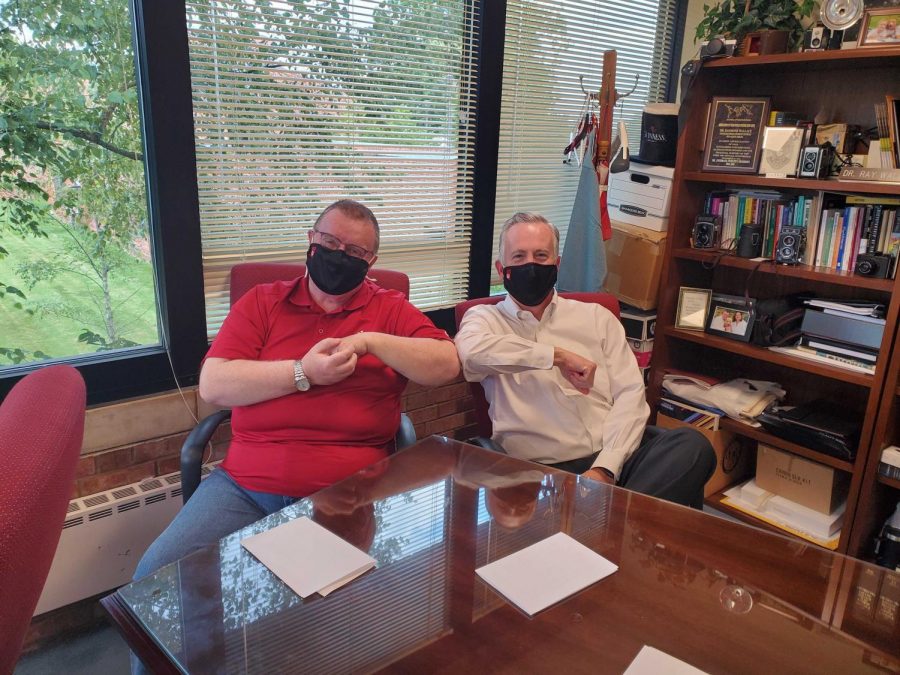IUS administration reflects on President McRobbie’s tenure
Chancellor Wallace and Vice Chancellor Wavle remember the progress made by IUS under President McRobbie’s leadership and discuss their hopes for the next president of IU
Chancellor Ray Wallace (left) and Vice Chancellor for Administrative Affairs Dana Wavle share an elbow bump during their discussion of IU retiring President Michael McRobbie’s legacy.
October 23, 2020
The IUS University Center during COVID-19 is so quiet that the air conditioning stands out sharply over the hushed sounds of footfalls on the plush carpet and the soft shuffling of paper as the university works with a skeleton crew. But in a break from the eerie silence, Chancellor Ray Wallace and Vice Chancellor for Administrative Affairs Dana Wavle decided to discuss the legacy and perception of IU President Michael McRobbie with student media, hoping to shed some light on the complicated and varied changes that have been made to IU, and by extension IUS, over the past 13 years.
The Importance of McRobbie’s Legacy
After an opinion story published by the Indiana Daily Student condemned President McRobbie’s legacy and suggested that his tenure was one of “empty promises” and “mishandled issues”, the IU Board of Trustees, as well as alumnus Luke Fields, stood in defense of McRobbie and his presidency, calling the aforementioned story “decent sleight of hand” and lauded his tenure for ensuring that “an IU education remains affordable and accessible for our students.”
In light of this controversy and in an effort to enlighten students to President McRobbie’s contributions to IUS and the IU system as a whole, Chancellor Wallace and Vice Chancellor Wavle shared their personal views on McRobbie before his retirement.
“President McRobbie is internationally known as a higher education administrator… I have enjoyed his leadership,” Wallace said. “I think his leadership has been, in many ways, great for us.”
Many campuses, One.IU
One of the first issues brought to bear by the IDS opinion column was the lack of availability President McRobbie had for Bloomington students and issues on the Bloomington campus. And although Fields, in his letter to the IDS, said McRobbie was much more available than some would claim, Chancellor Wallace and Vice Chancellor Wavle set out another reason for his possible lack of available time.
“You have to remember too, how much the size of the university has grown over his tenure from when he started in 2007.” said Wavle, who has been with IUS since 2009. “I think what you’re really seeing is this organization getting bigger and bigger and bigger and he’s the CEO of the university in addition to being the president, so he has to be visionary.”
Wavle explained that, if not for McRobbie’s strong vision for a unified university, IU, and by extension IUS, would be much less streamlined and standardized, leading to waste of resources, money and time.
“I think I came in at the end of one era and at the beginning of another era, where we were just about making that transition from being seven autonomous campuses to being one IU, and that means a lot of things.” said Wavle. “It means that we do things the same way for the regional campuses, we charge the same tuition rates, and that helps students so that you don’t have tuition all across the board.”
He said that, under McRobbie’s leadership, IU cut several redundant or inefficient practices in favor of a joint approach to administrative tasks, keeping the complexity for both students and administrators much below the hectic days of the separate campus administrations and allowing students to feel at home on any of the IU campuses.
“We have one CrimsonCard now. It used to be that we had seven different student IDs, seven , different parking permits. Now we just have the student ID… one parking permit… one police department.” Wavle said. “That whole idea of one IU, that’s President McRobbie.”
Student housing and other projects
Beyond the unification of the regional campuses, Wallace credits McRobbie as one of the central figures in many of IUS’ renovations and improvements. He went as far as saying that without McRobbie’s leadership and fundraising acumen, IUS would most likely be without the radio station, student housing, the library and, most recently, the new parking lot.
“He has helped us in a number of ways. He has helped us in terms of garnering us scholarships that we didn’t have before. He’s helped us in a lot of the projects,” said Wallace.
Wavle continued the chancellor’s line of thought by pointing out that, before McRobbie’s leadership, IUS was nearly unfit for the size of today’s student body and the needs of a technologically and demographically complex campus.
“I think one of the big advancements for this campus was the addition of student housing back in 2008, and that wouldn’t have happened without President McRobbie’s support and his endorsement,” said Wavle. “Student housing really transformed the campus. Similarly, in 2005, he helped us get capital money for the library. I crawled through a ceiling panel and went to the old library… it wasn’t suitable for our purposes as the campus continued to grow.”
Wallace even said that McRobbie frequently showed support for admittedly small projects on the IUS campus, from Samtec internships to commemorative plaques, attending several events and unveilings with intentions of meeting students and campus faculty and staff.
“We have a plaque out there in the front lawn over there for one of our first African-American students,” said Wallace. “He didn’t have to come to that. We were there to celebrate this plaque that commemorates an important milestone in our history as a campus and he comes down, ‘Great!’”
Just the right amount of oversight
One of the most fervent praises of McRobbie’s tenure from both Wallace and Wavle was his lack of micromanagement and deft ability to delegate tasks to a team. Wavle pointed out his innovation of “strengthening the layer of vice presidents” while Wallace said that his experience within other large universities and their administrations was on par, if not slightly lacking, in comparison to IU.
“I have been in systems like this,” Wallace said. “He certainly does pay attention. When I talk to my fellow chancellors at other regionals he certainly does pay attention to them, he does talk to them, same with us. I get the right amount of interest in the campus, yet at the same time I think we’re allowed to grow fairly freely.”
Wavle said that, at the high complexity of IU’s current structure, the president is needed in a more advisory and visionary capacity, rolling out the guidelines and big picture work while the administrative team uses their strengths to accomplish the task ahead. He noted that criticisms of McRobbie’s lack of involvement most likely stem from a misunderstanding of the magnitude of the role that being involved in every decision would be.
“Imagine if there was a model out there where you would try to put the responsibility of every decision on one individual in this multi-billion dollar organization… it’s impossible, you couldn’t do it,” Wavle said. “In fact if you could last six months it would be surprising.”
One of the main examples of this sort of leadership in action, according to Wavle, is the way IU is handling the COVID-19 pandemic, starting with his unified push for all-online course on March 10.
“Think of the world outside IU and all the things that we’ve dealt with since 2007,” Wavle said. “You had the Great Recession of 2008-2009 and COVID and everything that’s happening with COVID. The president, we would both say, has led right from the front with COVID and has been very proactive… We had just the right amount of campus autonomy to make the university plan fit at IU Southeast and it worked remarkably well.”
Going forward
After reminiscing about McRobbie’s legacy and the many changes that entailed for IUS, Wallace and Wavle shifted toward the future of IU and what they’d like to see going forward. They both agreed that McRobbie’s replacement would have a massive job ahead of them to live up to the legacy left in McRobbie’s wake and that the applicants for the position would be of a high caliber given McRobbie’s history of “raising our game and raising our reputation.”
“The next person has big shoes to fill,” Wallace said.
Finally, Wallace gave his opinion on what he felt should stay the same as IU moved on from McRobbie and forward into the future. Among the list were student friendliness, openness to diversity, scholarship advancements, fundraising and support for diverse student organizations, but Wallace made a very specific plea for an understanding of the “Hoosier spirit”.
“[President McRobbie] understands Midwestern, Hoosier, Hoosierness,” Wallace said. “He’s from another country, I’m from another country, we understand and appreciate what this state has and is and I think he’s done a good job trying to keep tuition reasonable [while] at the same time trying to continue to build a world class university.”



